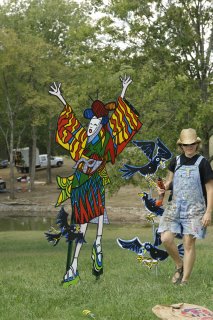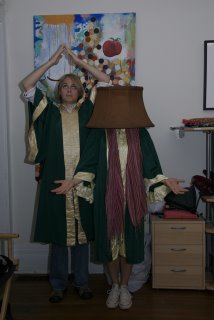
Andee worked with Don Evans and the Little Marrowbone Repair Corporation to complete Kakashi Jorou...a Geisha Scarecrow for the Scarecrows! at Cheekwood Art & Gardens in Nashville, TN.
SCARECROWS!
September 29 - November 4
www.cheekwood.org
Get ready for some good old-fashioned fall fun at Cheekwood! Scarecrows will showcase dozens of fabulous, weird, funny, and traditional scarecrows lurking along the Garden paths.
For the Birds
Hungry birds have always been a problem for farmers. Birds, such as crows, sometimes ate so much corn or wheat that farmers did not have enough food to last through the winter. So, for more than 3,000 years, farmers have been making scarecrows. As long as birds are hungry, farmers will still look for ways to SCARECROWS!
While we know our straw-filled friends as scarecrows, the protective characters have many different names. In Britain, they are called mommets, tattie bogies and hodmedods. Other places around the world scarecrows are known as jack-of-straws, scarebirds, and shoy-hoys.
Scarecrow Stories
(or Stories of Scarecrow, which do you like better)
The scarecrow is one of the most familiar figures of the rural landscape not only in the United States but throughout the world. His ragged figure has been recorded in rural history for centuries. We think of scarecrows as human-like figures stuffed with straw, but farmers have invented many different "scarecrows" to protect their crops over the years.
The first scarecrows in recorded history were placed along the Nile River to protect wheat fields from flocks of quail. Egyptian farmers covered wooden frames with fishing nets. The farmers hid in the fields and scared the quail into the nets.
Japanese farmers also began making scarecrows to protect their rice fields. The farmers hung old rags, meat, and fish bones from bamboo poles in their fields and then set them on fire. The smell was so bad that birds, and all other living creatures, stayed far away from the crops. The Japanese farmers called their scarecrows kakashis, which literally means something that smells bad.
In Medieval Britain, their scarecrows weren't made from wood or bamboo, but were live boys and girls. Known as bird scarers or bird shooers, they patrolled wheat fields carrying bags of stones. If crows landed in the fields, they would chase them off by waving their arms and throwing the stones.

